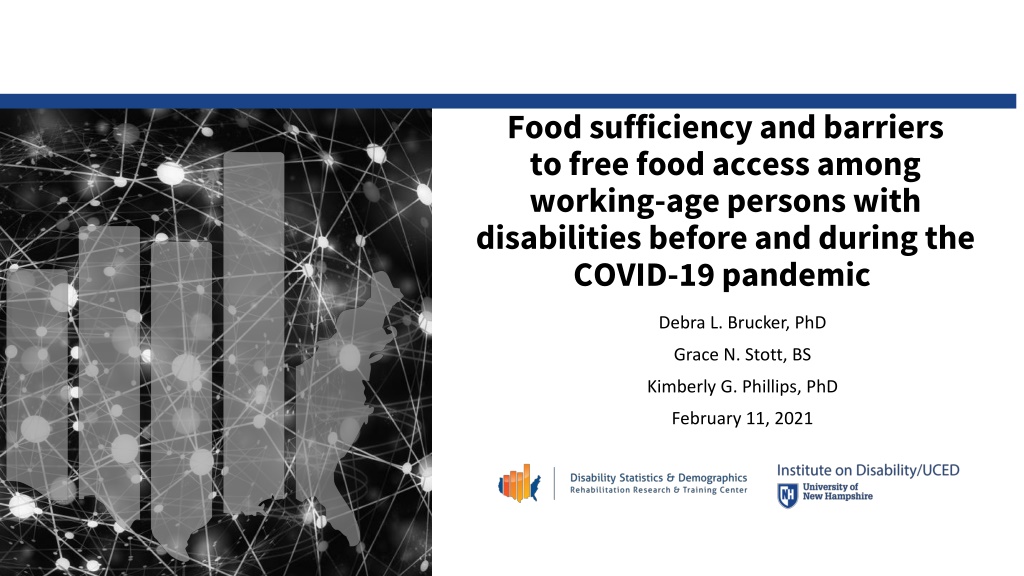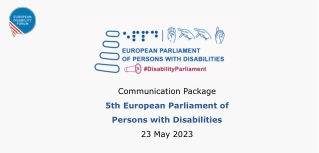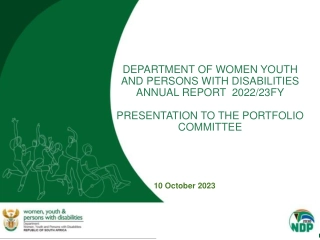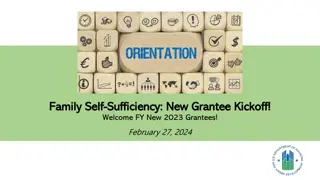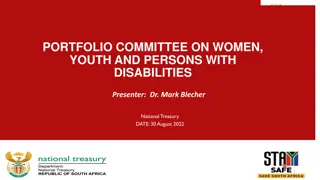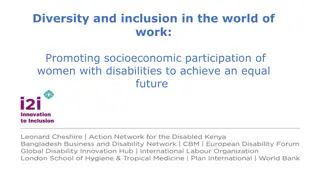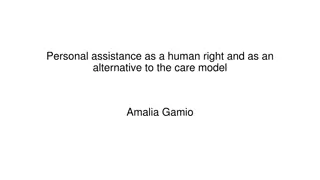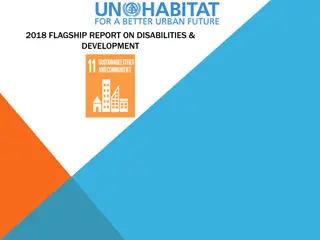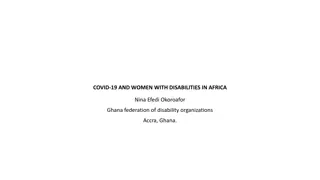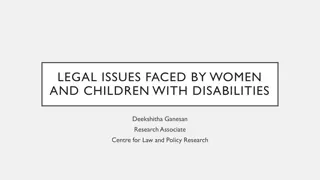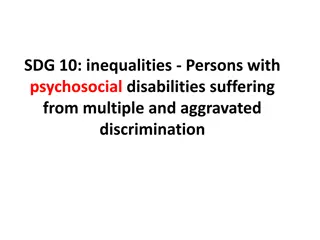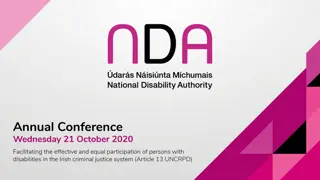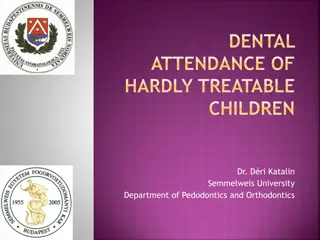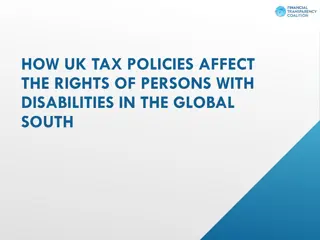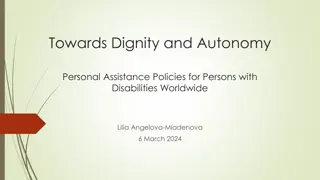Food Sufficiency and Barriers to Free Food Access Among Working-Age Persons with Disabilities Before and During COVID-19 Pandemic
Working-age persons with disabilities face economic vulnerability and higher chances of living in food-insecure households. This study explores food sufficiency and barriers to accessing free food during the COVID-19 pandemic. Data was collected through an online survey, revealing insights into food sufficiency, access to free food sources, and concerns regarding accessing free food among individuals with and without disabilities. The research sheds light on the challenges faced by this population in ensuring food security.
Download Presentation

Please find below an Image/Link to download the presentation.
The content on the website is provided AS IS for your information and personal use only. It may not be sold, licensed, or shared on other websites without obtaining consent from the author. Download presentation by click this link. If you encounter any issues during the download, it is possible that the publisher has removed the file from their server.
E N D
Presentation Transcript
Food sufficiency and barriers tofree food access among working-age persons with disabilitiesbefore and during the COVID-19pandemic Debra L. Brucker, PhD Grace N. Stott, BS Kimberly G. Phillips, PhD February 11, 2021
Acknowledgements This research was supported by grant 90RTGE0001 from the Administration for Community Living (ACL) s National Institute for Disability, Independent Living, and Rehabilitation Research (NIDILRR) grant H133B130015 from the U.S. Department of Health and Human Services (HHS), and by grant T73MC33246 from the HHS Maternal and Child Health Bureau, Health Resources and Services Administration (HRSA), administered by the Association of University Centers on Disabilities (AUCD). The contents of this article do not necessarily represent the views or policies of HHS, ACL, NIDILRR, HRSA, and you should not assume endorsement by the Federal Government or AUCD.
Background Working-age persons with disabilities are an economically vulnerable population who are more likely to live in food insecure households. They may also experience more individual or structural level barriers to accessing food. The U.S. Census has been running a Household Pulse Survey since April 2020 which has tracked, among other things, changes in food sufficiency for Americans during the pandemic. While the survey provides data broken out by many subpopulations, it does not provide information about food sufficiency for persons with disabilities.
Methods: Data collection An online Qualtrics survey (N=13, 277) of working-age individuals with and without disabilities was conducted in September 2020. The survey collected demographic information as well as a measure of food sufficiency prior to COVID-19 and within the last 7 days. Information about receipt of free groceries or meals or use of food programs or pantries in the past 7 days, barriers faced using food programs or food pantries, and participants confidence in affording foods they needed over the next 4 weeks was collected as well.
Methods: Analysis Descriptive statistics and multivariate methods were used to provide estimates of food sufficiency, access to sources of free food, and concerns with accessing free food among working-age individuals with and without disabilities in the U.S.
Measures: Focal independent variable Disability 1) Is deaf or have serious difficulty hearing? 2) Is blind or have serious difficulty seeing even when wearing glasses? 3) Does have serious difficulty concentrating, remembering, or making decisions? 4) Does have serious difficulty walking or climbing stairs? 5) Does- have difficulty dressing or bathing? 6) Does--have difficulty doing errands?
Measures Dependent variables Pre- and during COVID: Food sufficiency (USDA food sufficiency screener)= I had enough of the kinds of food I wanted to eat During COVID (September 2020): Any receipt of free groceries or meals or use of food programs or pantries Sources of free food Concerns with accessing free food Covariates Age, gender, race, ethnicity, employment, income, Supplemental Nutrition Assistance Program benefits
Food sufficiency among working-age persons with and without disabilities in the U.S., pre- and during the COVID-19 pandemic Adjusted food sufficiency estimates for working-age individuals in the U.S. 90.00 80.00 70.00 60.00 50.00 40.00 30.00 20.00 10.00 0.00 Pre-COVID During COVID Disability No disability Adjusted for age, employment, ethnicity, income, SNAP participation, race & region. Pre-COVID = March 2020; During COVID = September 2020
Reasons for food insufficiency among working-age persons with and without disabilities, September 2020 Disability No Sig. disability % % Couldn t afford 90.9 80.9 *** Couldn t get out 71.9 60.1 *** Afraid to go out 73.2 67.8 *** Couldn t get delivery 73.1 80.2 *** Stores didn t have food I wanted 74.3 76.1 Sig.=Significance; ***p<.001
Receipt of any free food in the past week among working-age persons with and withoutdisabilities, September 2020 Disability No disability Sig. % % Any free food in the past 7 days 58.7 40.9 *** Sources of free food: School or other program aimed at children 39.9 40.9 Food pantry or food bank 48.3 41.4 *** Home delivered (like Meals on Wheels) 34.6 35.4 Religious institution 39.9 37.8 Shelter or soup kitchen 32.2 28.1 *** Other community program 38.2 34.7 *** Family, friends, or neighbors 85.9 83.3 *** Sig.=Significance; ***p<.001
Concerns with accessing free food among working-age persons with disabilities, September 2020 DISABILITY Sig. AOR Paperwork 1.59 *** Qualify ing 1.79 *** Not wanting to rely on food programs/pantries 1.80 *** No transportation to food program/pantry 1.76 *** Long lines, wait times 1.76 *** Fewer deliveries or reduced hours due to COVID 1.69 *** Difficulty preparing food obtained from food program/pantry *** 1.80 Worried others will find out I use these programs 1.85 *** Adjusted for age, ethnicity, gender, income, race, & region Sig.=Significance; ***p<.001
Key Findings Working-age persons with disabilities were more likely than others to: Face food insufficiency, both before and during the pandemic Access any free food during the pandemic Access free food from Food pantries or food banks Shelters or soup kitchens Other community programs Family, friends, or neighbors
Key Findings (continued) When accessing free food, working-age persons with disabilities were more likely to note concerns with: Paperwork Eligibility Not wanting to rely on programs Transportation to the program/pantry Long lines or wait times Fewer deliveries or reduced hours due to COVID Difficulty preparing food obtained from programs Worrying that others will find out that they use these programs
Debra L. Brucker, PhD, University of New Hampshire debra.brucker@unh.edu (603) 862-1643 Contact Information
